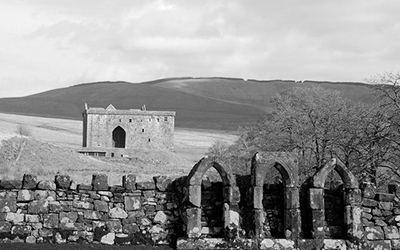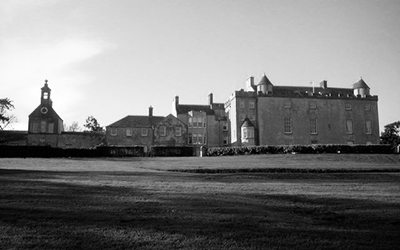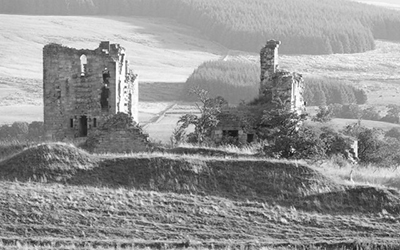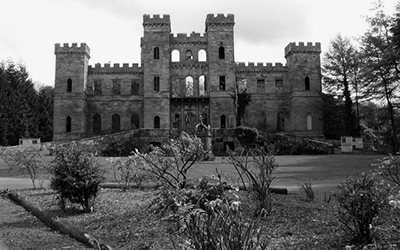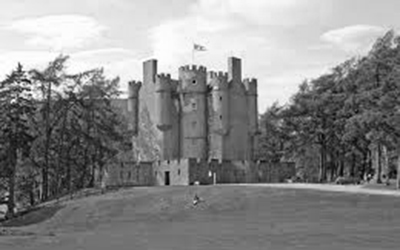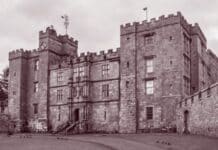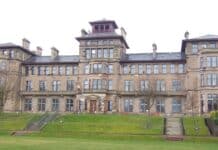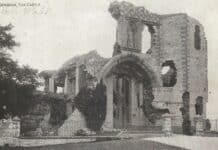Thousands of castles dot the Scottish landscape, several populated by a variety of ghosts. MJ STEEL COLLINS looks at some of the less-well known haunted Scottish castles.
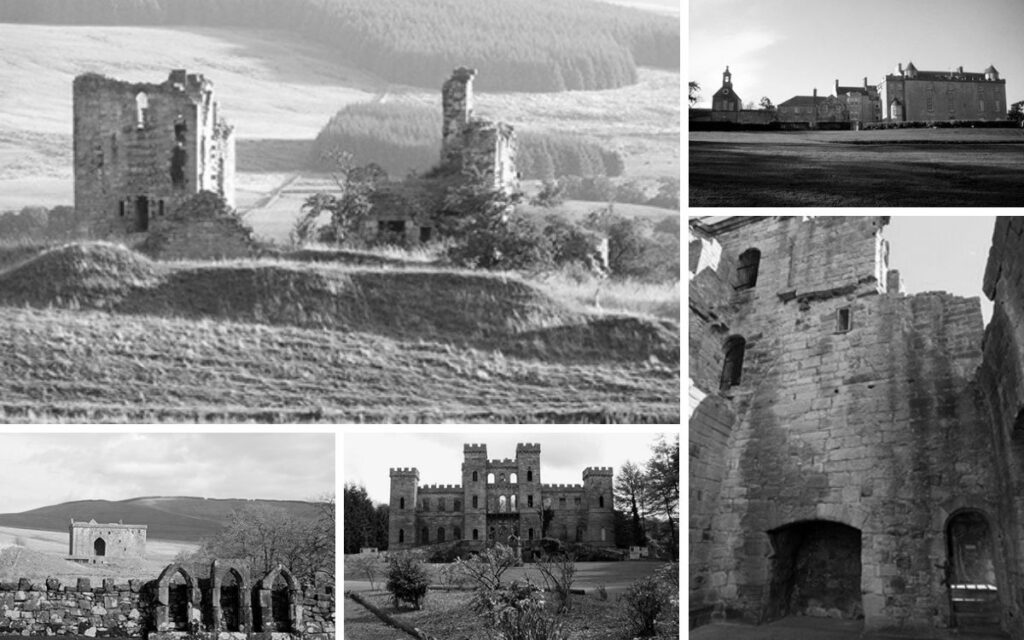
Hermitage Castle, Roxburghshire
Twelve miles from Hawick, ruined Hermitage dates back to the 13th century, believed to have been built by the Soulis family. One Lord Soulis was reputedly a practitioner of the Dark Arts; he regularly kidnapped local children and imprisoned them in the dungeon until he required them for a ritual. One day, the locals had enough. They stormed the castle, capturing Soulis, who was then clad in iron chains, wrapped in a lead blanket and boiled alive in his cauldron. Soulis’ ghost haunts Hermitage, whilst the cries of his young victims are still said to ring out around the ruins.
Another ghost at Hermitage is that of Sir Alexander Ramsay, who was thrown into Hermitage’s dungeons in 1342 and left to starve by Sir William Douglas, after Douglas contested Ramsay being made Sherriff of Teviotdale.
The castle is now owned by Historic Scotland.
Sundrum Castle, Ayrshire
Situated near Coylton, Sundrum Castle dates back to the 14th century built by Sir Robert Wallace, Sherriff of Ayr, and incorporated into a mansion house by the Hamilton family in 1742. Sundrum is home to a Green Lady, whose history is somewhat vague – though it’s thought she was a daughter of the Hamiltons. In common with other Green Ladies, apparently she met a bad end in the quest for love. This particular castle ghost forms part of my family’s spooky folklore. During the 1970s, Sundrum Castle functioned as a hotel, and my Gran worked as one of the housekeeping staff. She found it quite a creepy place. Working alone in one room, she made up the bed, turned her back for a second and turned round to find the sheets rumpled up, as if someone had slept in it….
Sundrum now forms the centre of a holiday park.
Sanquhar Castle, Dumfries and Galloway
Now a ruin, Sanquhar was once the home to the Crichtons of Dumfries, who built it in the 13th century. A number of significant figures in Scottish history visited the castle, including Robert the Bruce and Mary, Queen of Scots. The Crichtons sold Sanquhar to Sir William Douglas, 1st Duke of Queensberry in the 17th century, but he let it fall to ruin after building Drumlanrig Castle a mere ten miles away. The Marquis of Bute, John Crichton-Stuart, attempted to restore Sanquhar Castle in 1895, but didn’t get far.
READ: 5 Haunted Places To Visit in Lanarkshire, Scotland
Sanquhar is haunted by two ghosts. One, John Wilson, was the innocent victim of a spat in the 1590s between his employer, Sir Thomas Kirkpatrick, and Douglas of Drumlanrig, an associate of Robert Crichton, Lord of Sanquhar and Sherriff of Nithsdale. Crichton had Wilson locked up on trumped up charges, and subsequently hanged him when Sir Thomas Kirkpatrick protested. The second ghost is thought to be Marion Dalpeddar, presumed another victim of the vicious Robert Crichton. She is described as a beautiful White Lady. Interestingly a skeleton, which still had long blonde hair attached to the skull, was found in Sanquhar Castle in the 1870s.
Crookston Castle, Glasgow
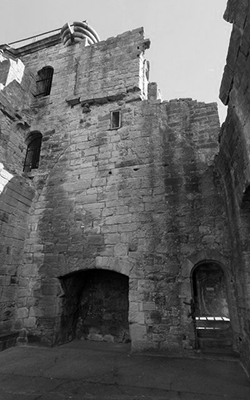
A 15th century castle located in Pollok, which perhaps owes some of its ruinous state to being blasted by Mons Meg in 1489, on the orders of King James IV in response to John Stewart, Lord Darnley, rebelling against him. This is the same Stewart family into which Mary, Queen of Scots married when she wed second husband, Henry Stewart, Lord Darnley. The castle was also besieged by the Earl of Arran and Cardinal Beaton in 1544, during one of those long drawn out fallouts Scottish nobility was prone to at the time.
The ghost that haunts Crookston is somewhat vague. A paranormal group carrying out an ‘unofficial’ investigation circa 2008 claimed to have made contact with a tetchy female ghost called Elspeth or Elspet. Strange things have been reported by others in the castle.
Crookston is owned by Historic Scotland and open to the public.
Eilean Donan Castle, Ross-shire
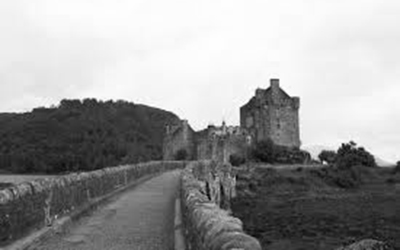
Located near Kyle of Lochalsh, Eilean Donan has served as both the setting for atrocity and the Highlander films. Built in the 13th century by Clan Mackenzie and Clan Macrae to defend the coast against the Vikings, the castle was also a hideout for Robert the Bruce. In 1331, the Earl of Moray ordered the beheading of 50 men and their heads were displayed on the castle walls. It also played a role in the Jacobite rebellions, before being destroyed by the English government in 1719. Eilean Donan was restored from its ruinious state by Lt Colonel John Macrae- Gilstrap from 1911 to 1932.
The castle is haunted by the ghost of a Spanish soldier, who died when itwas attacked by the government during a Jacobite uprising, and also a female ghost called Lady Mary.
Loudon Castle, East Ayrshire
A rather modern entry on the list, which dates to the 19th century. Loudon Castle lies near Galston, and from 1995 to 2010 was also the site of Loudon Castle theme park. For most of its existence, the castle has been a ruin, having being accidentally set on fire in the 1940s. It is haunted by a Grey Lady and a ghostly dog with glowing eyes.
Duntrune Castle, Argyllshire
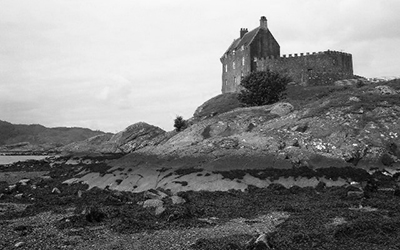
Located at the north side of Loch Crinan, Duntrune was built by Clan MacDougall in the 12th century, and taken over by Clan Campbell in 1644. It is one of the oldest continuously occupied castles in Scotland.
The ghost that haunts Duntrune is that of a piper. He served Coll Ciotach, an Irish man with a grudge against the Campbells, and who planned to attack Duntrune. Unsure of the odds he faced, Ciotach sent his piper in to evaluate the situation. Pipers held a privileged position in Highland society, and were guaranteed hospitality. Ciotach’s piper was welcomed by the Campbells, but they became suspicious about his overt curiosity about Duntrune. Not entirely sure what to do, the Campbells locked the piper in a tower room. Meanwhile, Ciotach and his men grew impatient and made plans to move in on the castle. The piper knew that that Campbells vastly outnumbered them, so to warn Ciotach, played his pipes, which had been locked in with him. Realising what was afoot, the Campbells cut the piper’s fingers off, and he bled to death.
Since then, he has haunted Duntrune, causing poltergeist phenomenon and playing his pipes from the tower. About 100 years ago, a fingerless skeleton was found in the castle walls and given a Christian burial, but this failed to appease the ghost, as it was still active afterwards.
Braemar Castle, Aberdeenshire
Owned by the Chieftain of Clan Farquharson, Braemar was built in 1628 by the 18th Earl of Mar, John Erskine, ironically to hold back the Farquharsons. It played a part in the Jacobite uprisings; being torched during the 1689 rebellion by the Black Colonel John Farquharson, and forfeited to the Crown in 1716 after the Earl of Mar supported the 1715 uprising. Thereafter, it was purchased by the Farquharsons, who let it to the government for use as an army garrison, though the castle itself was a ruin. It was returned to the Farquharsons in 1831, and restored during Victoria’s reign.
As to the ghosts that haunt the castle, they include that of a young bride who committed suicide at some point in the 19th century. After her wedding day, she woke to find her husband missing, and believed he had abandoned her. She committed suicide in despair, when in fact he had only gone on an early morning hunt. The bride’s ghost seeks out newly married men who stay at the castle. Braemar also boasts a ghostly piper, and the Black Colonel’s shade has been seen flitting about.
The castle is now open to the public, leased out by the Farquharsons to the local community.
Newton Castle, Perthshire
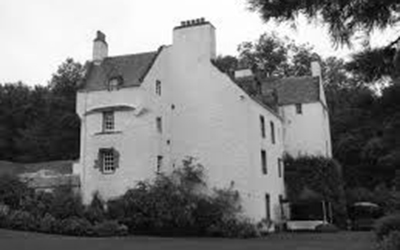
Located in Blairgowrie, Newton is the seat of Clan Macpherson, and dates back to the 16th century, with the usual later additions. According to a traditional ballad, The Green Ladye of Newton, a Green Lady haunts the castle. The story goes that Lady Jean, or Jane, Drummond was a beautiful young woman who had fallen in love with the local Laird, but found her advances rebuffed. Desperate, she went to a local witch, who advised her to attire herself in the cloth of the fairies. In order to do this, Jean was to take an offering comprising of grass taken from the local churchyard and tied by plaited reed to a Rowan branch, cut from a tree on the gallows hill.
Sitting with her eyes closed, Jean felt as if the wind was pulling at her clothes and heard tinkling laughter. At dawn, she opened her eyes, and found herself wearing the ‘Witchin Claith of Green’. Despite being suitably clothed (Scottish folklore doesn’t follow logic at times), she headed to Newton Castle, where she was due to marry Lord Ronald, who wasn’t the man she loved. After the wedding, Ronald looked at his new wife and saw she look distressed. He took her hand, which was icy cold. Jean shrieked and died on the spot. The witch had failed to tell Jean that the Witchin Claith couldn’t be worn without impunity. Jean was buried at Knockie Hill, rather than the churchyard as she died under enchantment. Her ghost rises from her grave on Hallowe’en – after the stone on top rotates three times – and floats to Newton Castle, where she can be heard singing sadly.
Tioram Castle, Lochaber
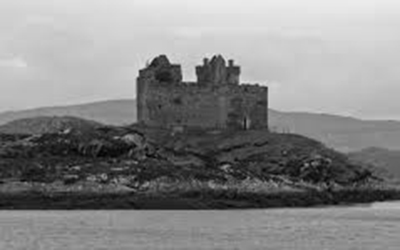
Pronounced “chee-rum”, Tioram Castle is a ruin that sits on Eilean Tioram (The Dry Island) in Loch Moidart, where it meets the River Sheil. The castle has been a ruin for over two centuries, and owing to its precarious condition, not open to the public, though it can be viewed from a safe distance by visiting Eilean Tioram. The castle was once seat of Clan MacDonald of Clanranald, and also featured in the Jacobite uprisings. It has been uninhabited since the 1715 rebellion.
The ghost story attached to Tioram Castle is weird even by the standards of Scottish folklore. It doesn’t involve a ghost, but demonic frog that followed the 12th Clanranald Chief, John, wherever he went. It could escape locked rooms and even appeared when he sailed away from the haunted Scottish castle. In the last instance, the frog demanded to be brought aboard the boat, but John refused. The frog then caused weather so ferocious that those accompanying the Chieftain thought they were going to drown, so the frog was begrudgingly allowed on board.


